View in other NatureServe Network Field Guides
NatureServe
Montana
Utah
Wyoming
Idaho
Wisconsin
British Columbia
South Carolina
Yukon
California
New York
Red-spotted Admiral - Limenitis arthemis
General Description
Two basic but variable phenotypes, the taxonomy still in flux (see for example Mullen et al. 2008).
[From Ferris and Brown 1981; Scott 1986; Opler and Wright 1999; Glassberg 2001; Pyle 2002]
Limenitis arthemis arthemis (WHITE ADMIRAL); Forewing 2.9-3.7 cm. Wing margins scalloped, uppersurface black; forewing with outwardly curved broad white median band and a few apical white spots, hindwing with postmedian white band, submarginal series of red spots, marginal row of blue dashes; undersurface reddish-brown with white bands and spots as on uppersurface, 2-3 large reddish-orange spots near dark wing bases.
Limenitis arthemis astyanax (RED-SPOTTED PURPLE); Forewing 3.5-4.8 cm. Wing margins scalloped, uppersurface blue to blue green, outer portion of hindwing more iridescent; undersurface of forewing pale orangish apical region and iridescent blue in the basal half, forewing with 2 large reddish-orange costal spots near dark wing base, hindwing with 3 reddish-orange spots near dark wing base and a submargional series of reddish-orange spots.
Phenology
One flight in the north, mid-July to mid-August in Labrador and mid-June to mid-August in southern Saskatchewan; one flight mid-June to mid-July and partial second flight in August in Ontario; two flights, June to September in New York; many flights in the south, march to November in Florida and April to November in Arizona (Scott 1986). Late May to early Septmber, mainly mid-June to mid-August (Glassberg 2001).
Diagnostic Characteristics
White Admiral best determined by a combination of the bold white bands, the uppersurface hindwing with submarginal series of red spots and marginal row of blue dashes, undersurface of wings with 2-3 large reddish-orange spots near dark wing bases.
Red-spotted Purle best determined by a combination of the uppersurface blue to blue green, outer portion of hindwing more iridescent, the forewing undersurface with 2 large reddish-orange costal spots near dark wing base, hindwing with 3 reddish-orange spots near dark wing base and a submargional series of reddish-orange spots.
Species Range
Montana Range
Range Descriptions
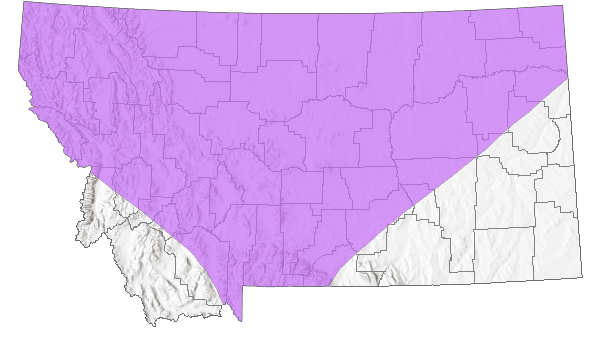
 Native
Native
Range Comments
Alaska south and east across subarctic Canada to New England (L. a. arthemis); a hybrid zone across the northern US from North Dakota through the Great Lakes region to New York and Massachusetts; most of eastern US (L. a. astyanax), with isolated southwestern populations (L. a. astyanax or L. a. arizonensis, depending on the authority) in Arizona, New Mexico, western Texas south to northern Mexico (Scott 1986; Opler and Wright 1999; Glassberg 2001; Mullen et al. 2008). In Montana only the northern subspecies (L. a. arthemis) reported, from at least 8 counties along or near the Canadian border (Kohler 1980; Stanford and Opler 1993). Uncommon to common (Glassberg 2001).
Observations in Montana Natural Heritage Program Database
Number of Observations: 21
(Click on the following maps and charts to see full sized version)
Map Help and Descriptions
Relative Density
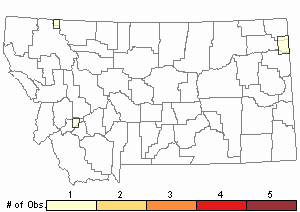
Recency
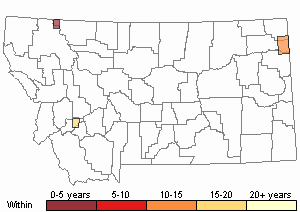

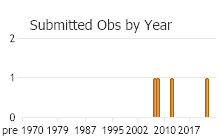
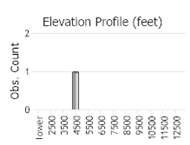 (Observations spanning multiple months or years are excluded from time charts)
(Observations spanning multiple months or years are excluded from time charts)
Migration
Non-migratory.
Habitat
Moist deciduous broadleaf woodlands, evergreen oak-pine forest, mixed evergreen forest, forest edges, clearings, orchards, glades, streambanks (Ferris and Brown 1981; Opler and Wright 1999; Glassberg 2001; Pyle 2002). In Glacier National Park, Montana reported from montane mesic meadows (Debinski 1993).
Ecological Systems Associated with this Species
- Details on Creation and Suggested Uses and Limitations
How Associations Were Made
We associated the use and habitat quality (common or occasional) of each of the 82 ecological systems mapped in Montana for
vertebrate animal species that regularly breed, overwinter, or migrate through the state by:
- Using personal observations and reviewing literature that summarize the breeding, overwintering, or migratory habitat requirements of each species (Dobkin 1992, Hart et al. 1998, Hutto and Young 1999, Maxell 2000, Foresman 2012, Adams 2003, and Werner et al. 2004);
- Evaluating structural characteristics and distribution of each ecological system relative to the species' range and habitat requirements;
- Examining the observation records for each species in the state-wide point observation database associated with each ecological system;
- Calculating the percentage of observations associated with each ecological system relative to the percent of Montana covered by each ecological system to get a measure of "observations versus availability of habitat".
Species that breed in Montana were only evaluated for breeding habitat use, species that only overwinter in Montana were only evaluated for overwintering habitat use, and species that only migrate through Montana were only evaluated for migratory habitat use.
In general, species were listed as associated with an ecological system if structural characteristics of used habitat documented in the literature were present in the ecological system or large numbers of point observations were associated with the ecological system.
However, species were not listed as associated with an ecological system if there was no support in the literature for use of structural characteristics in an ecological system,
even if point observations were associated with that system.
Common versus occasional association with an ecological system was assigned based on the degree to which the structural characteristics of an ecological system matched the preferred structural habitat characteristics for each species as represented in scientific literature.
The percentage of observations associated with each ecological system relative to the percent of Montana covered by each ecological system was also used to guide assignment of common versus occasional association.
If you have any questions or comments on species associations with ecological systems, please contact the Montana Natural Heritage Program's Senior Zoologist.
Suggested Uses and Limitations
Species associations with ecological systems should be used to generate potential lists of species that may occupy broader landscapes for the purposes of landscape-level planning.
These potential lists of species should not be used in place of documented occurrences of species (this information can be requested at:
mtnhp.mt.gov/requests) or systematic surveys for species and evaluations of habitat at a local site level by trained biologists.
Users of this information should be aware that the land cover data used to generate species associations is based on imagery from the late 1990s and early 2000s and was only intended to be used at broader landscape scales.
Land cover mapping accuracy is particularly problematic when the systems occur as small patches or where the land cover types have been altered over the past decade.
Thus, particular caution should be used when using the associations in assessments of smaller areas (e.g., evaluations of public land survey sections).
Finally, although a species may be associated with a particular ecological system within its known geographic range, portions of that ecological system may occur outside of the species' known geographic range.
Literature Cited
- Adams, R.A. 2003. Bats of the Rocky Mountain West; natural history, ecology, and conservation. Boulder, CO: University Press of Colorado. 289 p.
- Dobkin, D. S. 1992. Neotropical migrant land birds in the Northern Rockies and Great Plains. USDA Forest Service, Northern Region. Publication No. R1-93-34. Missoula, MT.
- Foresman, K.R. 2012. Mammals of Montana. Second edition. Mountain Press Publishing, Missoula, Montana. 429 pp.
- Hart, M.M., W.A. Williams, P.C. Thornton, K.P. McLaughlin, C.M. Tobalske, B.A. Maxell, D.P. Hendricks, C.R. Peterson, and R.L. Redmond. 1998. Montana atlas of terrestrial vertebrates. Montana Cooperative Wildlife Research Unit, University of Montana, Missoula, MT. 1302 p.
- Hutto, R.L. and J.S. Young. 1999. Habitat relationships of landbirds in the Northern Region, USDA Forest Service, Rocky Mountain Research Station RMRS-GTR-32. 72 p.
- Maxell, B.A. 2000. Management of Montana's amphibians: a review of factors that may present a risk to population viability and accounts on the identification, distribution, taxonomy, habitat use, natural history, and the status and conservation of individual species. Report to U.S. Forest Service Region 1. Missoula, MT: Wildlife Biology Program, University of Montana. 161 p.
- Werner, J.K., B.A. Maxell, P. Hendricks, and D. Flath. 2004. Amphibians and reptiles of Montana. Missoula, MT: Mountain Press Publishing Company. 262 p.
- Commonly Associated with these Ecological Systems
Grassland Systems
Wetland and Riparian Systems
- Occasionally Associated with these Ecological Systems
Forest and Woodland Systems
Shrubland, Steppe and Savanna Systems
Wetland and Riparian Systems
Food Habits
Larval food plants for the northern arthemis subspecies include Alnus, Amelanchier, Betula, Carpinus, Crataegus, Fagus, Malus, Populus, Prunus, Salix, Tilia, and Ulmus; larval food plants for the southern and eastern astyanax subspecies include Carpinus, Crataegus, Cydonia, Malus, Populus, Prunus, Pyrus, Quercus, Salix, and Tilia (Ferris and Brown 1981; Scott 1986). Adults feed on flower nectar (including Aster, Eutrochium, Rhus), sap, rotting fruit, carrion, dung, honeydew, cercopid spittle, decaying wood, mud (Voss 1954; Reed 1958; Downes 1973; Scott 1986; Lederhouse 1993; Wise 2010).
Reproductive Characteristics
Females lay eggs singly on the uppersurface of host plant leaf tips (Scott 1986; Guppy and Shepard 2001). Following egg-hatch larvae build no nest but eventually create a leaf-tip silk-bound hibernaculum and overwinter as L3 instar, rarely L2 or L4 (Scott 1979, 1986), although in British Columbia hibernation by L2 instar may be more prevalent (Guppy and Shepard 2001). Post-diapause larve develop through L4-L5 and pupate (second generation males as L4, females as L5); pupae suspended from base (Guppy and Shepard 2001; Pyle 2002). Males territorial mid-day through afternoon, perch >80 % of time on trees and tall bushes 1-3 m above ground along flyways, patrol < 15% of time while awaiting passage of females (Scott 1983; Lederhouse 1993; Guppy and Shepard 2001); in Arizona and Texas, males patrol throughout the day near host plants, sometimes on hilltops (Scott 1975b, 1986).
Stewardship Responsibility
References
- Literature Cited AboveLegend:
 View Online Publication
View Online Publication Debinski, D. 1993. Butterflies of Glacier National Park, Montana. Occasional Papers of the Museum of Natural History, the University of Kansas, Lawrence, Kansas. No. 159: 1-13.
Debinski, D. 1993. Butterflies of Glacier National Park, Montana. Occasional Papers of the Museum of Natural History, the University of Kansas, Lawrence, Kansas. No. 159: 1-13. Downes, J.A. 1973. Lepidoptera feeding at puddle-margins, dung, and carrion. Journal of the Lepidopterists' Society 27(2): 89-99.
Downes, J.A. 1973. Lepidoptera feeding at puddle-margins, dung, and carrion. Journal of the Lepidopterists' Society 27(2): 89-99. Ferris, C.D. and F.M. Brown (eds). 1981. Butterflies of the Rocky Mountains. Univ. of Oklahoma Press. Norman. 442 pp.
Ferris, C.D. and F.M. Brown (eds). 1981. Butterflies of the Rocky Mountains. Univ. of Oklahoma Press. Norman. 442 pp. Glassberg, J. 2001. Butterflies through Binoculars: A Field Guide to the Butterflies of Western North America. Oxford University Press.
Glassberg, J. 2001. Butterflies through Binoculars: A Field Guide to the Butterflies of Western North America. Oxford University Press. Guppy, C.S. and J.H. Shepard. 2001. Butterflies of British Columbia: including western Alberta, southern Yukon, the Alaska Panhandle, Washington, northern Oregon, northern Idaho, northwestern Montana. UBC Press (Vancouver, BC) and Royal British Columbia Museum (Victoria, BC). 414 pp.
Guppy, C.S. and J.H. Shepard. 2001. Butterflies of British Columbia: including western Alberta, southern Yukon, the Alaska Panhandle, Washington, northern Oregon, northern Idaho, northwestern Montana. UBC Press (Vancouver, BC) and Royal British Columbia Museum (Victoria, BC). 414 pp. Kohler, S. 1980. Checklist of Montana Butterflies (Rhopalocera). Journal of the Lepidopterists' Society 34(1): 1-19.
Kohler, S. 1980. Checklist of Montana Butterflies (Rhopalocera). Journal of the Lepidopterists' Society 34(1): 1-19. Lederhouse, R.C. 1993. Territoriality along flyways as mate-locating behavior in male Limenitis arthemis (Nymphalidae). Journal of the Lepidopterists' Society 47: 22-31.
Lederhouse, R.C. 1993. Territoriality along flyways as mate-locating behavior in male Limenitis arthemis (Nymphalidae). Journal of the Lepidopterists' Society 47: 22-31. Opler, P.A. and A.B. Wright. 1999. A field guide to western butterflies. Second edition. Peterson Field Guides. Houghton Mifflin Company, Boston, Massachusetts. 540 pp.
Opler, P.A. and A.B. Wright. 1999. A field guide to western butterflies. Second edition. Peterson Field Guides. Houghton Mifflin Company, Boston, Massachusetts. 540 pp. Pyle, R.M. 2002. The butterflies of Cascadia: a field guide to all the species of Washington, Oregon, and surrounding territories. Seattle Audubon Society, Seattle, Washington. 420 pp.
Pyle, R.M. 2002. The butterflies of Cascadia: a field guide to all the species of Washington, Oregon, and surrounding territories. Seattle Audubon Society, Seattle, Washington. 420 pp. Reed, H.B., Jr. 1958. A study of dog carcass communities in Tennessee, with special reference to the insects. American Midland Naturalist 59(1): 213-245.
Reed, H.B., Jr. 1958. A study of dog carcass communities in Tennessee, with special reference to the insects. American Midland Naturalist 59(1): 213-245. Scott, J.A. 1975b. Mate-locating behavior of western North American butterflies. Journal of Research on the Lepidoptera 14:1-40.
Scott, J.A. 1975b. Mate-locating behavior of western North American butterflies. Journal of Research on the Lepidoptera 14:1-40. Scott, J.A. 1979. Hibernal diapause of North American Papilionoidea and Hesperioidea. Journal of Research on the Lepidoptera 18(3): 171-200.
Scott, J.A. 1979. Hibernal diapause of North American Papilionoidea and Hesperioidea. Journal of Research on the Lepidoptera 18(3): 171-200. Scott, J.A. 1986. The butterflies of North America: a natural history and field guide. Stanford University Press, Stanford, California.
Scott, J.A. 1986. The butterflies of North America: a natural history and field guide. Stanford University Press, Stanford, California. Stanford, R.E. and P.A. Opler. 1993. Atlas of western USA butterflies: including adjacent parts of Canada and Mexico. Unpubl. Report. Denver and Fort Collins, Colorado 275 pp.
Stanford, R.E. and P.A. Opler. 1993. Atlas of western USA butterflies: including adjacent parts of Canada and Mexico. Unpubl. Report. Denver and Fort Collins, Colorado 275 pp. Voss, E.G. 1954. The butterflies of Emmet and Cheboygan counties, Michigan with other notes on northern Michigan butterflies. American Midland Naturalist 51(1): 87-104.
Voss, E.G. 1954. The butterflies of Emmet and Cheboygan counties, Michigan with other notes on northern Michigan butterflies. American Midland Naturalist 51(1): 87-104. Wise, M.J. 2010. Limenitis arthemis astyanax (Fabricius) (Nymphalidae) sipping cercopid-spittle on tall goldenrod, Solidago altissima L. (Asteraceae). Journal of the Lepidopterists' Society 64(4): 217-218.
Wise, M.J. 2010. Limenitis arthemis astyanax (Fabricius) (Nymphalidae) sipping cercopid-spittle on tall goldenrod, Solidago altissima L. (Asteraceae). Journal of the Lepidopterists' Society 64(4): 217-218.
- Additional ReferencesLegend:
 View Online Publication
View Online Publication
Do you know of a citation we're missing? Allen, T.J., J.P. Brock, and J. Glassberg. 2005. Caterpillars in the field and garden: a field guide to the butterfly caterpillars of North America. Oxford University Press.
Allen, T.J., J.P. Brock, and J. Glassberg. 2005. Caterpillars in the field and garden: a field guide to the butterfly caterpillars of North America. Oxford University Press. Brock, J.P. and K. Kaufman. 2003. Kaufman Field Guide to Butterflies of North America. Houghton Mifflin Company, New York, NY 284 pp.
Brock, J.P. and K. Kaufman. 2003. Kaufman Field Guide to Butterflies of North America. Houghton Mifflin Company, New York, NY 284 pp. Debinski, D. M. 1991. Inventory and monitoring of biodiversity: an assessment of methods and a case study of Glacier National Park, MT. Ph.D. Dissertation. Montana State University, Bozeman. 205 p.
Debinski, D. M. 1991. Inventory and monitoring of biodiversity: an assessment of methods and a case study of Glacier National Park, MT. Ph.D. Dissertation. Montana State University, Bozeman. 205 p. Forister, M.L., C.A. Halsch, C.C. Nice, J.A. Fordyce, T.E. Dilts, J.C. Oliver, K.L. Prudic, A.M. Shapiro, J.K. Wilson, J. Glassberg. 2021. Fewer butterflies seen by community scientists across the warming and drying landscapes of the American West. Science 371:1042-1045.
Forister, M.L., C.A. Halsch, C.C. Nice, J.A. Fordyce, T.E. Dilts, J.C. Oliver, K.L. Prudic, A.M. Shapiro, J.K. Wilson, J. Glassberg. 2021. Fewer butterflies seen by community scientists across the warming and drying landscapes of the American West. Science 371:1042-1045. Forister, M.L., E.M. Grames, C.A. Halsch, K.J. Burls, C.F. Carroll, K.L. Bell, J.P. Jahner, et al. 2023. Assessing risk for butterflies in the context of climate change, demographic uncertainty, and heterogeneous data sources. Ecological Monographs 93(3):e1584. https://doi.org/10.1002/ecm.1584
Forister, M.L., E.M. Grames, C.A. Halsch, K.J. Burls, C.F. Carroll, K.L. Bell, J.P. Jahner, et al. 2023. Assessing risk for butterflies in the context of climate change, demographic uncertainty, and heterogeneous data sources. Ecological Monographs 93(3):e1584. https://doi.org/10.1002/ecm.1584 Layberry, R.A., P.W. Hall, and J.D. LaFontaine. 1998. The Butterflies of Canada. University of Toronto Press. 280 pp. + color plates.
Layberry, R.A., P.W. Hall, and J.D. LaFontaine. 1998. The Butterflies of Canada. University of Toronto Press. 280 pp. + color plates.
- Web Search Engines for Articles on "Red-spotted Admiral"
- Additional Sources of Information Related to "Insects"





